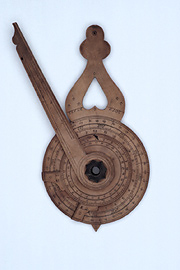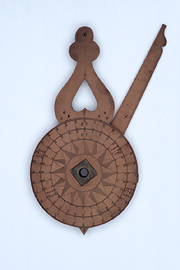|









| |
NAVIGATION
The
main tools of the navigator before the fifteenth century AD were personal
experience and the magnetic compass, sounding line and hourglass. Navigation
was only moderately certain on even the well established routes. But
Prince Henry the Navigator of Portugal (1394-1460) embarked upon an
ambitious exploration program that led to the adaptation of astronomical
instruments, including the astrolabe, for navigation. The mariner’s
astrolabe was sturdier than its terrestrial counterpart and typically
used simpler scales. The distance sailed could be calculated by using
it to measure the altitude of the Pole Star, or of the Sun at noon,
and then comparing that with the known altitude of those bodies at port.
(The nocturnal, of a similar design, was used to find the time at sea
by the orientation of the stars.) Mariner’s astrolabes are much
rarer today than other types of astrolabes both because they were often
of humbler materials and because some ended up at the bottom of the
sea.
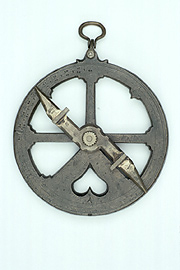 |
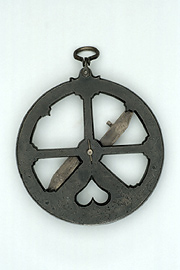 |
Mariner’s
Astrolabe
c. 1600
Maker unknown
Spain
Bronze
This mariner’s astrolabe was found during dredging at Vera
Cruz harbour in the Gulf of Mexico. The scale on the upper left
rim is for measuring the altitude and zenith distance of objects.
The alidade and fixing pin are modern replacements. |
Nocturnal
18th century
Maker unknown
England?
Pear Wood & Brass
Transferred from the Radcliffe Observatory
This nocturnal is unusual in that it can be used with either the
Great Bear or Little Bear constellations, “GB” and “LB”
on the smaller disc. The smaller disc also features a lunar scale. |
SURVEYING
Some
European instrument makers and mathematicians explored the use of the
astrolabe for surveying, too. As with navigation, surveying required
simpler features than did astronomy and astrology. The backs of astrolabes
intended for this use typically include a “shadow square,”
of a horizontal scale called the umbra recta and a vertical scale called
the umbra versa. These were graduated lines representing the shadows
cast by vertical and horizontal gnomons, as on a sundial. The astrolabe’s
alidade could be used to take the angular measurement of the height
of an object such as a tower. And then the lines of the shadow square,
the height of the tower and its distance to the observer formed triangles
that could be used to trigonometrically find the actual height. The
same procedure could be used to determine distances or the depth of
wells. In this sense, the astrolabe was a useful tool for the architect,
artist or soldier as well as the surveyor.
 |
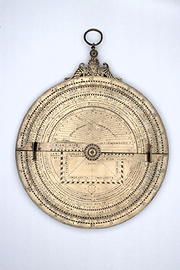 |
Universal
Astrolabe
1551
Made by Anthoine Mestrel
Paris
Brass
Billmeir Collection
This astrolabe features a universal projection associated with
a book on the astrolabe written by the Spanish mathematician Juan
de Rojas. The back includes a double shadow square and a plate
with a zodiac, calendar and stars. |
TRIANGULATION
A
method of using the astrolabe in map-making was also developed by Gemma
Frisius (1508-1555) the famed physician, mathematician, cartographer,
and globe and instrument maker. He attached his treatise on this traingulation
method to all of the editions of Apianus� Cosmographia that he published
after 1533. The Cosmographia was one of the most popular contemporary
astronomy textbooks. Frisius suggested using the astrolabe horizontally,
oriented with a compass, to take the bearings of terrestrial landmarks.
(Makers including his nephew, Gualterus Arsenius (fl. 1555-75), began
to add compasses to their astrolabes.) Frisius would then choose two
positions, take the bearings from them to a series of landmarks, and
measure one of the distances between. This created a network of proportional
triangles, as in surveying, that could be used to build a map of a territory
|



